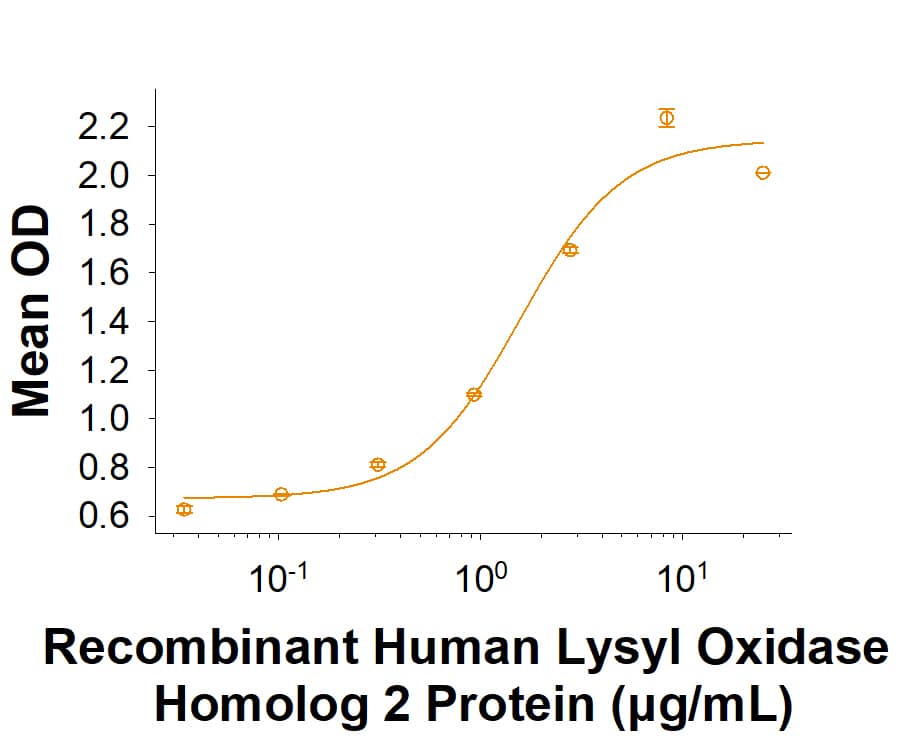Recombinant Human ADAMTS-L2 His-tag Protein, CF
R&D Systems, part of Bio-Techne | Catalog # 10950-AD

Key Product Details
Product Specifications
Source
Chinese Hamster Ovary cell line, CHO-derived human ADAMTSL2 protein
Asp23-Ser951 with a C-terminal 6-His tag
Asp23-Ser951 with a C-terminal 6-His tag
Purity
>95%, by SDS-PAGE visualized with Silver Staining and quantitative densitometry by Coomassie® Blue Staining.
Endotoxin Level
<0.10 EU per 1 μg of the protein by the LAL method.
N-terminal Sequence Analysis
Asp23
Predicted Molecular Mass
103 kDa
SDS-PAGE
130-144 kDa, under reducing conditions
Activity
Measured by its binding ability in a functional ELISA.
When Recombinant Human ADAMTSL2 His-tag (Catalog# 10950-AD) immobilized at 2.00 μg/mL, 100 μL/well, the concentration of Recombinant Human Lysyl Oxidase Homolog 2 Protein (Catalog # 2639-AO) that produces 50% of the optimal binding response is approximately 0.60-3.00 μg/mL.
When Recombinant Human ADAMTSL2 His-tag (Catalog# 10950-AD) immobilized at 2.00 μg/mL, 100 μL/well, the concentration of Recombinant Human Lysyl Oxidase Homolog 2 Protein (Catalog # 2639-AO) that produces 50% of the optimal binding response is approximately 0.60-3.00 μg/mL.
Scientific Data Images for Recombinant Human ADAMTS-L2 His-tag Protein, CF
Recombinant Human ADAMTS-L2 His-tag Protein Binding Activity.
When Recombinant Human ADAMTSL2 His-tag (Catalog# 10950-AD) is immobilized at 2.00 μg/mL, 100 μL/well, the concentration of Recombinant Human Lysyl Oxidase Homolog 2 Protein (2639-AO) that produces 50% of the optimal binding response is approximately 0.60-3.00 μg/mL.Recombinant Human ADAMTS-L2 His-tag Protein SDS-PAGE.
2 μg/lane of Recombinant Human ADAMTS-L2 His-tag Protein (Catalog # 10950-AD) was resolved with SDS-PAGE under reducing (R) and non-reducing (NR) conditions and visualized by Coomassie® Blue staining, showing bands at 130-144 kDa.Formulation, Preparation and Storage
10950-AD
| Formulation | Lyophilized from a 0.2 μm filtered solution in HEPES and NaCl with Trehalose. |
| Reconstitution | Reconstitute at 100 μg/mL in PBS. |
| Shipping | The product is shipped at ambient temperature. Upon receipt, store it immediately at the temperature recommended below. |
| Stability & Storage | Use a manual defrost freezer and avoid repeated freeze-thaw cycles.
|
Background: ADAMTSL2
References
- Mead, T.J. and S.S. Apte. (2018) Matrix Biol. 71:225.
- Koo, B. et al. (2007) Matrix Biol. 26:431.
- Hubmacher, D. and S. S. Apte. (2015) Matrix Biol. 47:34.
- Aviram, R. et al. (2019) Matrix Biol. 75-76:114-125.
- Le Goff, C. et al. (2008) Nat. Genet. 9:1119-23.
- Trenson, S. et al. (2021) Circ. Heart Fail. 14:e006979.
- Allali, S. et al. (2011) J. Med. Genet. 48:417.
- Marzin, P. et al. (2009) Gene Reviews. Internet:1993-2020.
- Zhang, A. et al. (2020) J. Biol. Chem. 295:15742.
- Steinle, J. et al. (2021) Am. J. Med. Genet. A. 185:743.
Long Name
ADAMTS-like Protein 2
Alternate Names
ADAMTSL2 ADAMTS-like 2, GPHYSD1
Entrez Gene IDs
9719 (Human)
Gene Symbol
ADAMTSL2
UniProt
Additional ADAMTSL2 Products
Product Documents for Recombinant Human ADAMTS-L2 His-tag Protein, CF
Product Specific Notices for Recombinant Human ADAMTS-L2 His-tag Protein, CF
For research use only
